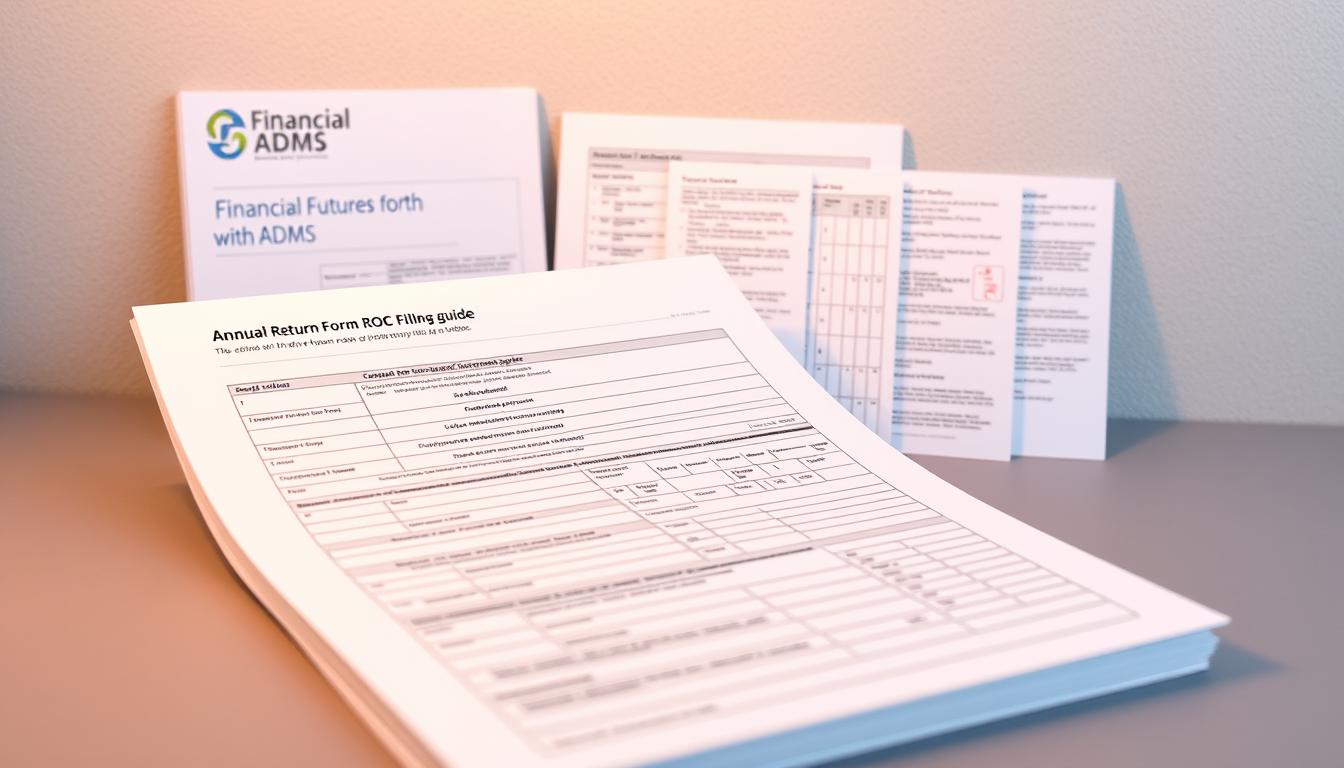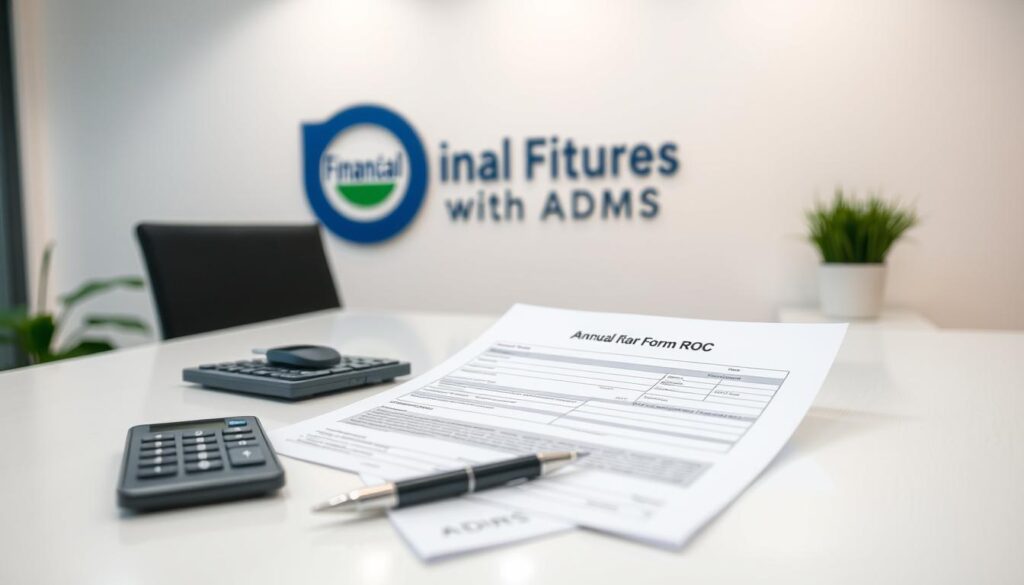How to Fill Annual Return Form ROC: Step-by-Step Guide

Filing the annual return form ROC is a key rule for companies in India. It’s required by The Companies Act, 2013.
Every company has to send in its audited financial statements and annual return within 30 and 60 days. This is after the Annual General Meeting. Not doing so can lead to big fines.
This guide will walk you through how to fill the ROC annual return form. It helps companies follow the law easily.
Key Takeaways
- Understanding the legal requirement for filing the annual return form ROC.
- Consequences of non-compliance with The Companies Act, 2013.
- Step-by-step guide to filling the ROC annual return form.
- Importance of timely submission of audited financial statements and annual return.
- Best practices for ensuring compliance.
Understanding the Annual Return Form ROC
It’s crucial for companies to understand the annual return form ROC to meet legal requirements. This form is based on Section 92 of the Companies Act, 2013, and Rule 11 of the Companies (Management and Administration) Rules, 2014.
What is an Annual Return Form?
The annual return form ROC is a document that companies must file. It shows their financial status, shareholding, and other corporate details for the year.
Legal Requirements Under Companies Act, 2013
The Companies Act, 2013 requires companies to file their annual return on time. If they don’t, they might face penalties and fines.
Form MGT-7 and Other Applicable Forms
Companies usually file their annual return using Form MGT-7. This form includes financial, director, and shareholder information. Depending on the company’s situation, other forms might be needed.
Deadlines and Penalties for Non-Compliance
Companies must file their annual return on time to avoid penalties. Not doing so can lead to big fines and legal trouble for the company and its officers.
Prerequisites Before Filing the Annual Return Form ROC

To file the Annual Return Form ROC, companies need to meet some requirements. They must have all the right documents and info. This is to follow the rules of the Companies Act, 2013.
Essential Documents and Information Checklist
Before filing, companies should make an essential documents checklist. This checklist includes:
- Company details and registration information
- Shareholding pattern and share transfer details
- Details of directors and key managerial personnel
- Financial statements and board reports
Digital Signature Certificate (DSC) Requirements
A Digital Signature Certificate (DSC) is needed for filing the Annual Return Form ROC. Companies must get a DSC from a licensed Certifying Authority.
Financial Statements and Board Reports Preparation
Companies must prepare their financial statements and board reports as per the Companies Act, 2013. This includes the balance sheet, profit and loss account, and notes to the financial statements.
Professional Certification Requirements
The Annual Return Form ROC needs to be certified by a professional, such as a Company Secretary. This certification makes sure the info is correct and follows the rules.
Step-by-Step Process to Fill the Annual Return Form ROC

Filing the Annual Return Form ROC is key for companies in India. It involves several steps to ensure a successful submission.
Accessing the MCA Portal and Login Procedure
First, companies need to get to the Ministry of Corporate Affairs (MCA) portal. They can do this by going to the official MCA website and finding the login area. They must log in with their user ID and password. It’s important to make sure the login details are right to avoid problems.
Selecting and Downloading the Correct Form
After logging in, companies need to pick the right form, which is the Annual Return Form ROC (Form MGT-7). They can download it from the MCA portal. It’s crucial to choose the correct form for the financial year in question.
Company Information and Registration Details
The next step is to fill in the company’s details. This includes the company name, registration number, and other important information. It’s vital to make sure the details are correct and match the ROC’s records.
Share Capital and Debentures Section
Then, companies need to enter information about their share capital and debentures. This includes the total share capital, shares issued, and any changes in the share capital during the year. They also need to provide details on debentures, if any.
Indebtedness and Securities Section
The next section is about loans and borrowings. Companies must list all loans and borrowings and provide details on securities offered for these loans.
Directors and Key Managerial Personnel Information
Lastly, companies need to give information about their directors and key managerial staff. This includes any changes in the board of directors and key staff during the year.
By following these steps, companies can fill the Annual Return Form ROC correctly. This ensures they meet all regulatory requirements.
Completing the Shareholders and Share Transfer Details
It’s important to fill out the shareholder and share transfer parts of the Annual Return Form ROC correctly. Companies need to make sure all shareholder and share transfer information is right.
Entering Shareholder Information Accurately
When you put in shareholder info, you must get it right. This means including names, addresses, and how many shares they own. Precision is crucial to avoid any problems or legal issues.
Recording Share Transfers During the Financial Year
Any share transfers in the financial year need to be recorded carefully. You should note who transferred the shares, who got them, and how many. Maintaining a clear record of these deals is key for following the rules.
Shareholding Pattern Documentation
Companies must document the shareholding pattern. This shows how shares are spread out among different types of shareholders. This is important for being open and following the rules.
Validation and Common Errors in Shareholder Data
Checking shareholder data is a must to make sure it’s correct and follows the rules. Mistakes can include wrong info, wrong share transfers, and not matching share patterns. Regular audits can spot and fix these problems.
Attachments and Certification Requirements
To file the annual return form with the ROC, companies must follow certain rules. The Ministry of Corporate Affairs (MCA) lists specific documents to attach to the form.
Mandatory Attachments List
The following documents are required for the roc form for annual return:
- Financial statements, including the balance sheet and profit & loss account
- Board’s report
- Auditors’ report
Optional Attachments When Applicable
Some companies might need to attach more documents. These include:
- Resolutions passed during the year
- Details of any amalgamations or mergers
Digital Signing Process by Directors/Officers
The annual return form needs a digital signature from a director or officer. This requires a Digital Signature Certificate (DSC) from a licensed authority.
“Digital signatures are a secure way to authenticate the identity of the signatory and ensure the integrity of the filed documents.”
Professional Certification by Company Secretary
A Company Secretary in practice must certify the annual return form. They confirm it meets the Companies Act, 2013 requirements.
By following these steps, companies can make the annual return form filing roc process easier.
Submission and Payment Process for Annual Return Form
Filing the Annual Return Form ROC needs accurate and smooth steps. Companies must follow the rules to avoid penalties or issues.
Fee Calculation Based on Company Type and Capital
The fee for filing the Annual Return Form ROC changes based on the company type and capital. Private limited companies and public limited companies have different fees. Here’s the fee schedule:
- Private Limited Company: Fee ranges from ₹400 to ₹5 lakh based on authorized capital.
- Public Limited Company: Fee ranges from ₹400 to ₹10 lakh based on authorized capital.
Payment Methods and Gateway Options
The Ministry of Corporate Affairs (MCA) portal offers many payment methods. You can use net banking, credit/debit cards, or online payment gateways.
Tracking Submission Status
After submitting the form, you can track its status on the MCA portal. This feature lets you monitor progress and solve any problems quickly.
Handling Rejection and Resubmission
If your form is rejected, you must fix the issues and resubmit it on time. The ROC will tell you what needs fixing.
Conclusion
Filing the annual return form ROC is key for companies under the Companies Act, 2013. It’s important to know the rules to avoid fines and keep good standing with the Registrar of Companies.
This article gives a clear guide on how to fill and submit the annual return form ROC. It covers the needed documents, digital signature requirements, and how to pay.
By using this guide, companies can meet the annual return form requirements roc. This ensures they operate transparently. Filing on time is also crucial to avoid extra costs and penalties.
In short, filing the annual return form ROC is essential for companies. They must focus on this to keep their legal status and avoid problems.


 Previous Post
Previous Post